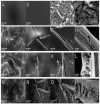Chitosan-Based Films with 2-Aminothiophene Derivative: Formulation, Characterization and Potential Antifungal Activity
- PMID: 35200633
- PMCID: PMC8878255
- DOI: 10.3390/md20020103
Chitosan-Based Films with 2-Aminothiophene Derivative: Formulation, Characterization and Potential Antifungal Activity
Abstract
In this study, films of chitosan and 2-amino-4,5,6,7-tetrahydrobenzo[b]thiophene-3-carbonitrile (6CN), a 2-aminothiophene derivative with great pharmacological potential, were prepared as a system for a topical formulation. 6CN-chitosan films were characterized by physicochemical analyses, such as Fourier-transform infrared spectroscopy (FTIR), differential scanning calorimetry (DSC), thermogravimetric analysis (TGA), X-ray diffraction (XRD), and scanning electronic microscopy (SEM). Additionally, the antifungal potential of the films was evaluated in vitro against three species of Candida (C. albicans, C. tropicalis, and C. parapsilosis). The results of the FTIR and thermal analysis showed the incorporation of 6CN in the polymer matrix. In the diffractogram, the 6CN-chitosan films exhibited diffraction halos that were characteristic of amorphous structures, while the micrographs showed that 6CN particles were dispersed in the chitosan matrix, exhibiting pores and cracks on the film surface. In addition, the results of antifungal investigation demonstrated that 6CN-chitosan films were effective against Candida species showing potential for application as a new antifungal drug.
Keywords: 2-aminothiophene derivative; antifungal activity; chitosan; films.
Conflict of interest statement
The authors declare no conflict of interest.
Figures








Similar articles
-
Characterization and Antiproliferative Activity of a Novel 2-Aminothiophene Derivative-β-Cyclodextrin Binary System.Molecules. 2018 Nov 29;23(12):3130. doi: 10.3390/molecules23123130. Molecules. 2018. PMID: 30501061 Free PMC article.
-
Chitosan-hydroxypropyl methylcellulose tioconazole films: A promising alternative dosage form for the treatment of vaginal candidiasis.Int J Pharm. 2019 Feb 10;556:181-191. doi: 10.1016/j.ijpharm.2018.12.011. Epub 2018 Dec 12. Int J Pharm. 2019. PMID: 30553009
-
Carboxymethyl chitosan as an antifungal agent on gauze.Int J Biol Macromol. 2018 Nov;119:166-171. doi: 10.1016/j.ijbiomac.2018.07.038. Epub 2018 Jul 26. Int J Biol Macromol. 2018. PMID: 30009895
-
Chitosan film containing antifungal agent-loaded SLNs for the treatment of candidiasis using a Box-Behnken design.Carbohydr Polym. 2022 May 1;283:119178. doi: 10.1016/j.carbpol.2022.119178. Epub 2022 Jan 24. Carbohydr Polym. 2022. PMID: 35153023
-
Chitosan-based films blended with moringa leaves and MgO nanoparticles for application in active food packaging.Int J Biol Macromol. 2023 Dec 31;253(Pt 6):127045. doi: 10.1016/j.ijbiomac.2023.127045. Epub 2023 Sep 28. Int J Biol Macromol. 2023. PMID: 37776934
Cited by
-
Tuning surface properties of thiophene-based thin films on glass substrates for cancer cell adhesion, drug release control, and computational analysis.Sci Rep. 2025 Jun 20;15(1):20170. doi: 10.1038/s41598-025-05691-w. Sci Rep. 2025. PMID: 40542057 Free PMC article.
-
Amphotericin B- and Levofloxacin-Loaded Chitosan Films for Potential Use in Antimicrobial Wound Dressings: Analytical Method Development and Its Application.Pharmaceutics. 2022 Nov 17;14(11):2497. doi: 10.3390/pharmaceutics14112497. Pharmaceutics. 2022. PMID: 36432684 Free PMC article.
-
Antifungal Chitosan Nanocomposites-A New Perspective for Extending Food Storage.Int J Mol Sci. 2024 Dec 8;25(23):13186. doi: 10.3390/ijms252313186. Int J Mol Sci. 2024. PMID: 39684896 Free PMC article.
-
Surfactant supported chitosan for efficient removal of Cr(VI) and anionic food stuff dyes from aquatic solutions.Sci Rep. 2023 Sep 22;13(1):15786. doi: 10.1038/s41598-023-43034-9. Sci Rep. 2023. PMID: 37737297 Free PMC article.
References
-
- Kummari L.K., Butler M.S., Furlong E., Blundell R., Nouwens A., Silva A.B., Kappler U., Fraser J.A., Kobe B., Cooper M.A., et al. Antifungal benzo[b]thiophene 1,1-dioxide IMPDH inhibitors exhibit pan- assay interference (PAINS) profiles. Bioorg. Med. Chem. 2018;26:5408–5419. doi: 10.1016/j.bmc.2018.09.004. - DOI - PubMed
-
- Scotti L., Scotti M.T., De Oliveira Lima E., Da Silva M.S., Do Carmo Alves De Lima M., Da Rocha Pitta I., De Moura R.O., De Oliveira J.G.B., Da Cruz R.M.D., Mendonça F.J.B. Experimental methodologies and evaluations of computer-aided drug design methodologies applied to a series of 2-aminothiophene derivatives with antifungal activities. Molecules. 2012;17:2298–2315. doi: 10.3390/molecules17032298. - DOI - PMC - PubMed
-
- Mendonça F.J.B., Lima-Neto R.G., de Oliveira T.B., de Lima M.C.A., Pitta I.R., Galdino S.L., da Cruz R.M.D., de Araújo R.S.A., Neves R.P. Synthesis and evaluation of the antifungal activity of 2-(substituted-amino)-4,5-dialkyl-thiophene-3-carbonitrile derivatives. Lat. Am. J. Pharm. 2011;30:1492–1499.
-
- de Araújo Neto L.N., do Carmo Alves de Lima M., de Oliveira J.F., de Souza E.R., Buonafina M.D.S., Vitor Anjos M.N., Brayner F.A., Alves L.C., Neves R.P., Mendonça-Junior F.J.B. Synthesis, cytotoxicity and antifungal activity of 5-nitro-thiophene-thiosemicarbazones derivatives. Chem. Biol. Interact. 2017;272:172–181. doi: 10.1016/j.cbi.2017.05.005. - DOI - PubMed
MeSH terms
Substances
Grants and funding
LinkOut - more resources
Full Text Sources

